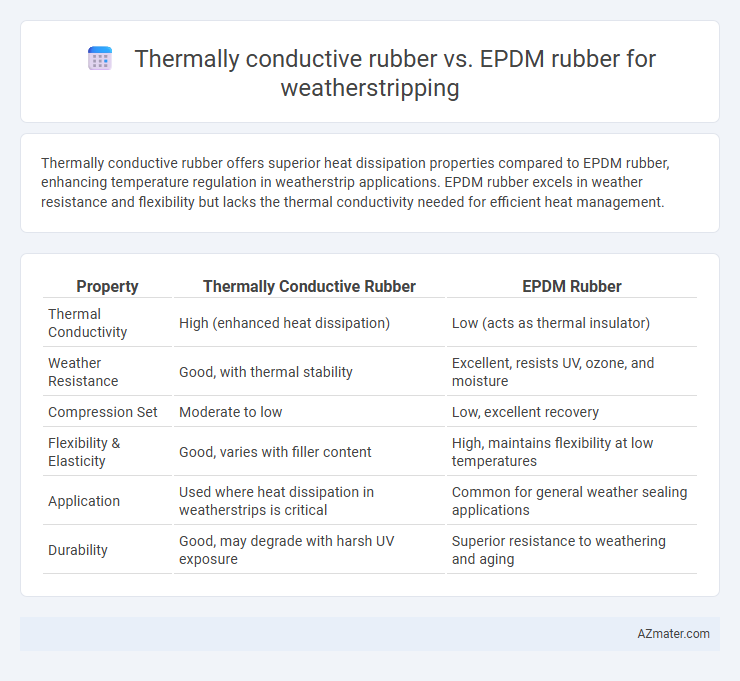Thermally conductive rubber offers superior heat dissipation properties compared to EPDM rubber, enhancing temperature regulation in weatherstrip applications. EPDM rubber excels in weather resistance and flexibility but lacks the thermal conductivity needed for efficient heat management.
Table of Comparison
| Property | Thermally Conductive Rubber | EPDM Rubber |
|---|---|---|
| Thermal Conductivity | High (enhanced heat dissipation) | Low (acts as thermal insulator) |
| Weather Resistance | Good, with thermal stability | Excellent, resists UV, ozone, and moisture |
| Compression Set | Moderate to low | Low, excellent recovery |
| Flexibility & Elasticity | Good, varies with filler content | High, maintains flexibility at low temperatures |
| Application | Used where heat dissipation in weatherstrips is critical | Common for general weather sealing applications |
| Durability | Good, may degrade with harsh UV exposure | Superior resistance to weathering and aging |
Introduction to Weatherstrips: Importance and Functions
Weatherstrips play a crucial role in sealing gaps around doors and windows, preventing air, water, and dust infiltration while enhancing energy efficiency. Thermally conductive rubber offers superior heat dissipation properties, making it ideal for applications requiring temperature regulation alongside sealing. EPDM rubber, known for its excellent weather resistance and flexibility, remains a popular choice for durable and reliable weatherstrip performance in diverse environmental conditions.
Overview of Thermally Conductive Rubber
Thermally conductive rubber is engineered to efficiently dissipate heat while maintaining flexibility and durability, making it ideal for applications requiring both insulation and thermal management. Unlike EPDM rubber, which primarily offers excellent weather resistance and elastic properties, thermally conductive rubber incorporates fillers such as graphite or silver to enhance heat transfer capabilities. This specialized rubber is commonly used in electronic enclosures, automotive seals, and weatherstrips where preventing overheating is crucial.
Properties and Characteristics of EPDM Rubber
EPDM rubber stands out in weatherstrip applications due to its exceptional resistance to heat, ozone, and weathering, making it ideal for outdoor environments. Its excellent elasticity and flexibility ensure a tight seal against water, air, and dust, while maintaining durability across a wide temperature range (-40degC to 125degC). Unlike thermally conductive rubber, EPDM lacks thermal conductivity but offers superior chemical resistance and long-lasting performance in automotive and industrial sealing solutions.
Thermal Conductivity: Key Differences
Thermally conductive rubber exhibits significantly higher thermal conductivity, typically ranging from 1 to 5 W/m*K, enabling efficient heat transfer critical in electronics and automotive applications. In contrast, EPDM rubber has low thermal conductivity, around 0.2 W/m*K, making it ideal for insulation and sealing in weatherstrip uses to prevent heat loss. The key difference lies in thermally conductive rubber's ability to dissipate heat rapidly, whereas EPDM provides superior thermal resistance and durability against environmental conditions.
Durability and Weather Resistance Comparison
Thermally conductive rubber offers enhanced durability with superior resistance to extreme temperatures and UV radiation, making it highly suitable for weatherstrip applications exposed to harsh environmental conditions. EPDM rubber is renowned for its exceptional weather resistance, particularly against ozone, sunlight, and water, but may degrade faster under prolonged high thermal stress compared to thermally conductive rubber. The choice between the two hinges on the specific operational temperature range and environmental exposure, where thermally conductive rubber provides better longevity in high-heat scenarios, while EPDM excels in general weather resistance and flexibility.
Impact on Energy Efficiency in Buildings and Automobiles
Thermally conductive rubber enhances energy efficiency in buildings and automobiles by facilitating heat dissipation, reducing thermal resistance, and maintaining temperature stability, which minimizes HVAC and engine cooling loads. EPDM rubber, while excellent in weather resistance and durability, acts as a thermal insulator, limiting heat transfer and potentially increasing energy consumption for heating and cooling systems. Choosing thermally conductive rubber for weatherstrips can improve overall thermal management, leading to lower energy costs and enhanced performance in climate control systems.
Application Suitability: Where Each Rubber Excels
Thermally conductive rubber excels in applications requiring efficient heat dissipation and enhanced thermal management, such as electronic enclosure seals and automotive battery insulation, where maintaining temperature balance is critical. EPDM rubber, known for its superior weather resistance, ozone durability, and flexibility at low temperatures, is ideal for exterior weatherstripping in building construction and automotive door seals exposed to harsh environmental conditions. Selecting between these materials depends on the primary functional requirement: thermal conductivity for temperature control or robust environmental sealing for long-term weather exposure.
Cost Considerations: Thermally Conductive Rubber vs EPDM
Thermally conductive rubber generally incurs higher material and manufacturing costs compared to EPDM rubber due to its specialized fillers and performance characteristics. EPDM rubber offers a cost-effective solution for weatherstripping applications with reliable weather, UV, and ozone resistance, making it suitable for most standard sealing tasks. Budget-sensitive projects favor EPDM for its affordability and easy processing, while thermally conductive rubber is selected for applications requiring heat dissipation despite the premium price.
Environmental Impact and Sustainability
Thermally conductive rubber used in weatherstrips often incorporates fillers like metal oxides or carbon-based materials, which may increase energy usage during manufacturing but enhance heat dissipation, potentially improving energy efficiency in building applications. EPDM rubber, derived from ethylene, propylene, and diene monomers, is known for its durability and resistance to weathering, with relatively low environmental impact due to its long lifespan which reduces replacement frequency. In terms of sustainability, EPDM can be more eco-friendly as it is often recyclable and poses fewer challenges in waste management compared to thermally conductive rubber composites containing non-biodegradable fillers.
Conclusion: Choosing the Right Weatherstrip Material
Thermally conductive rubber excels in applications requiring efficient heat dissipation alongside sealing, making it ideal for electronic enclosures or heat-sensitive environments. EPDM rubber offers superior weather resistance, UV stability, and flexible sealing properties, perfect for automotive or industrial weatherstripping exposed to extreme weather conditions. Selecting the right weatherstrip material depends on balancing thermal conductivity needs with environmental durability, where thermally conductive rubber suits thermal management, while EPDM is optimal for robust weatherproof sealing.

Infographic: Thermally conductive rubber vs EPDM rubber for Weatherstrip
 azmater.com
azmater.com